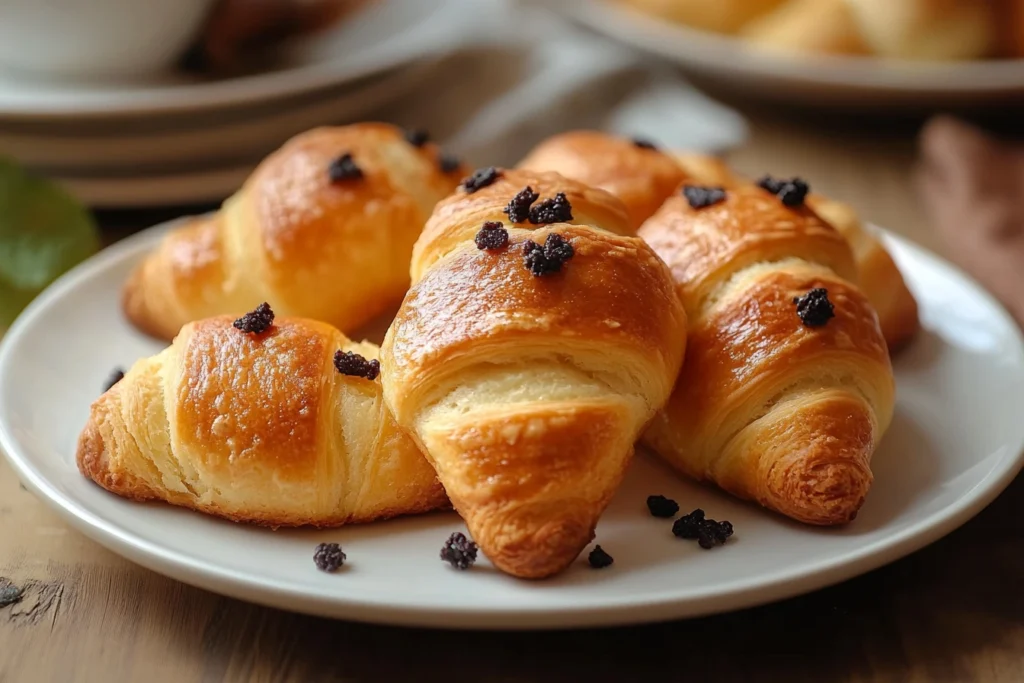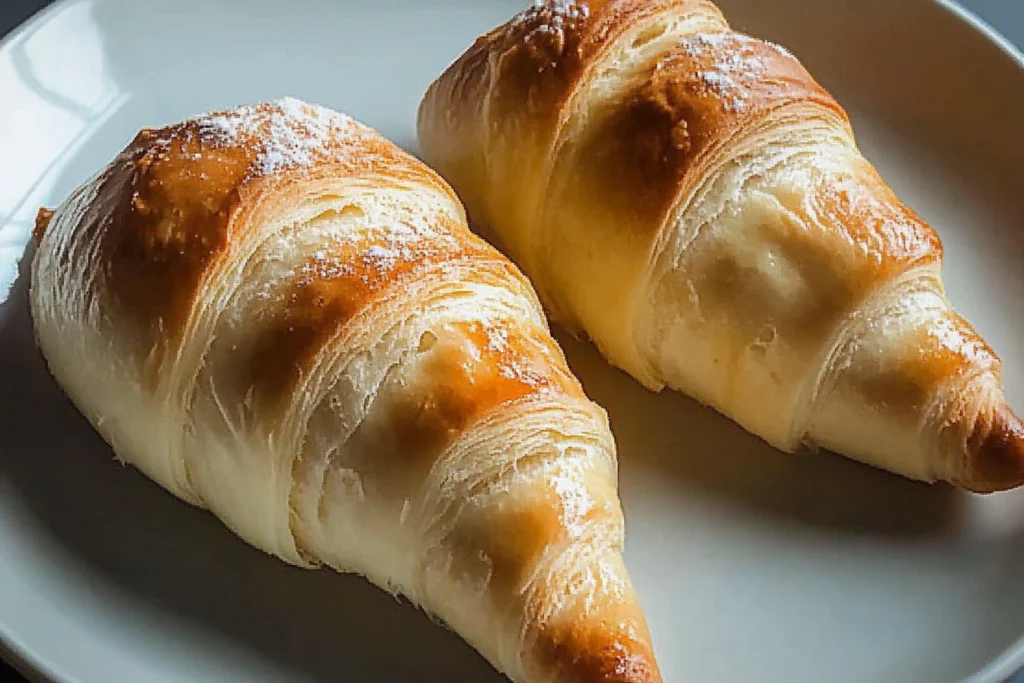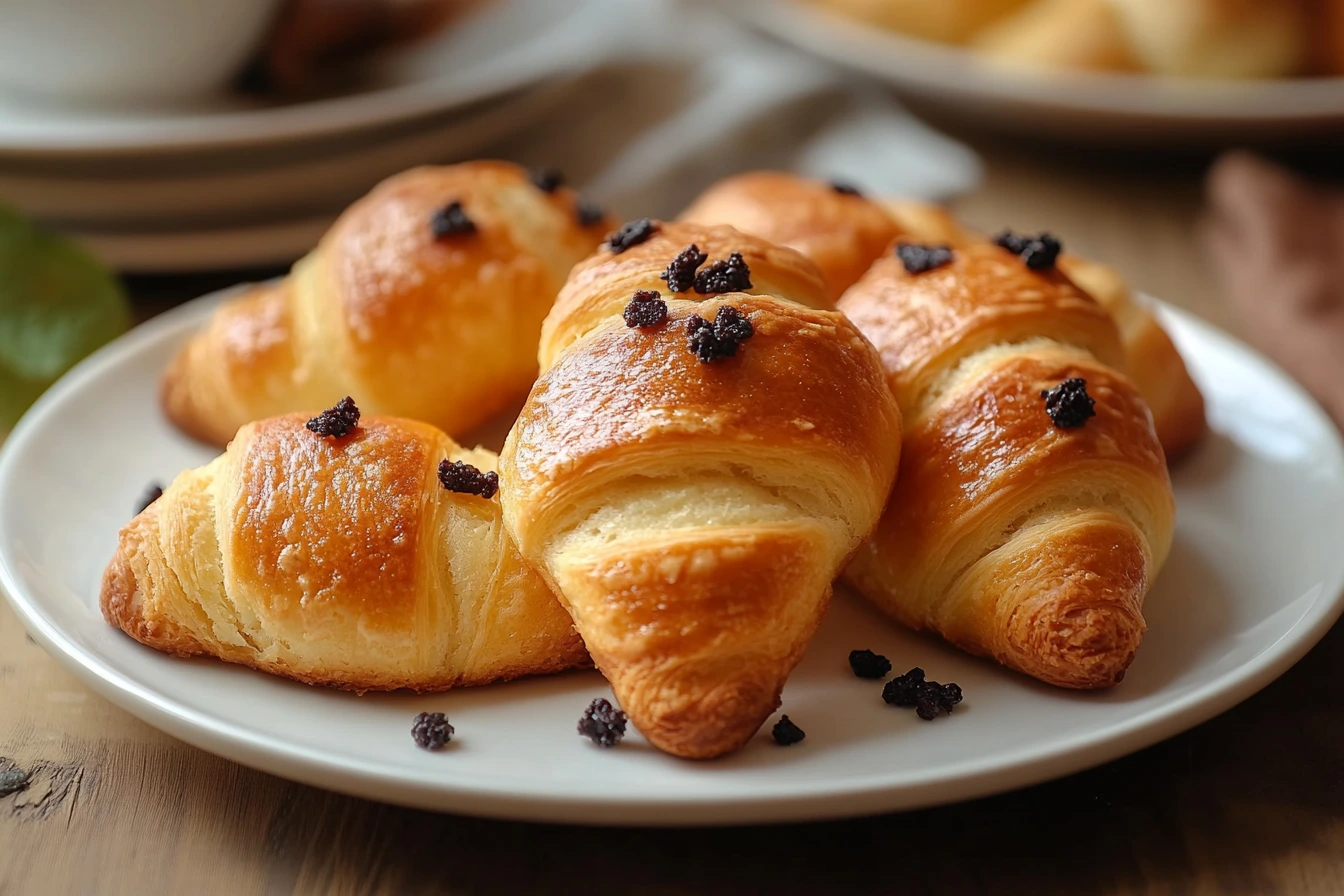What Is a Gipfeli?
A Gipfeli Recipe, often referred to as the Swiss version of the croissant, holds a special place in Swiss culinary tradition. While it shares similarities with the French croissant, including its crescent shape, it is distinct in both taste and texture. Originating in Switzerland, the Gipfeli Recipe is less buttery, slightly denser, and subtly sweeter than its French counterpart. This makes it an ideal choice for breakfast or as a light snack, especially when paired with a cup of coffee or tea.
The term “Gipfeli” originates from the Swiss-German word meaning “crescent,” a nod to its distinctive curved form. A beloved treat in Swiss bakeries for generations, this pastry is prized for its perfectly crisp, flaky crust and tender, airy interior.

Difference Between Gipfeli and French Croissants
Though they may look similar at first glance, the Gipfeli Recipe differs significantly from the French croissant. Gipfeli uses less butter in its dough, which contributes to its less oily texture. Additionally, while croissants are often made with laminated dough that results in multiple layers of puff pastry, Gipfeli dough is slightly less layered, giving it a firmer bite. The flavor profile also sets them apart, with Gipfeli offering a sweeter, more neutral base compared to the rich, buttery taste of croissants.
Another noteworthy difference lies in how they’re enjoyed. Croissants are commonly served plain or filled with sweet or savory ingredients. Gipfeli, however, often comes in various versions, including whole wheat, multigrain, and even vegan alternatives, showcasing its versatility in catering to modern dietary preferences.
Why Gipfeli Is a Staple in Swiss Bakeries
The Swiss culture places immense value on breakfast, and Gipfeli plays a starring role in this daily ritual. Its relatively simple recipe and accessible ingredients make it a favorite among both professional bakers and home cooks. Swiss bakeries are renowned for producing Gipfeli with consistent quality, ensuring that every bite delivers a satisfying blend of flakiness and flavor. Whether enjoyed fresh in the morning or reheated later in the day, Gipfeli remains an iconic part of Swiss gastronomy.
Ingredients for Swiss Gipfeli
Crafting the perfect Gipfeli Recipe begins with selecting the right ingredients. While the recipe may seem simple at first glance, the quality and combination of these ingredients are crucial for achieving the authentic flavor and texture that makes Gipfeli so beloved.
Essential Ingredients for Traditional Gipfeli
- Flour
The foundation of any great Gipfeli is the flour. Traditionally, Swiss Gipfeli recipes use all-purpose flour or a combination of all-purpose and bread flour. The choice of flour impacts the texture, with bread flour lending more structure and chewiness, while all-purpose flour keeps it tender. - Butter
High-quality unsalted butter is key to the flaky layers in Gipfeli. Swiss butter is often preferred due to its richer flavor and higher fat content, but any premium unsalted butter will work. - Milk
Milk provides a soft, slightly sweet flavor and helps create a tender crumb. Whole milk is recommended, as its fat content adds to the richness of the dough. - Yeast
Active dry yeast is the leavening agent typically used in Gipfeli dough. It gives the pastry its signature lightness and rise during baking. - Sugar
A touch of sugar enhances the flavor of the dough, adding a subtle sweetness without overpowering the buttery notes. - Eggs
Eggs enrich the dough and are also used for an egg wash, giving the baked Gipfeli their golden, glossy finish. - Salt
A small pinch of salt helps counterbalance the sweetness while enriching the overall flavor of the Gipfeli.
Alternative Ingredients for a Healthier Version
For those seeking a healthier twist, substitutions can be made without compromising too much on flavor or texture:
- Whole Wheat Flour: Replace part of the all-purpose flour with whole wheat flour for added fiber and a nuttier flavor.
- Plant-Based Butter: Use vegan butter alternatives for a dairy-free version.
- Low-Fat Milk: Swap whole milk for skim or plant-based milk, such as almond or oat milk, for fewer calories.
- Natural Sweeteners: Use honey or maple syrup instead of sugar for a more natural sweetness.
Gluten-Free and Vegan Substitutions
Creating gluten-free or vegan Gipfeli Recipe is entirely possible with a few adjustments:
- Gluten-Free Flour Blend: Use a high-quality gluten-free flour mix that contains xanthan gum or another binding agent for elasticity.
- Coconut Oil or Vegan Butter: These are great substitutes for traditional butter in vegan recipes.
- Flaxseed Egg: Mix ground flaxseed with water to replace eggs in the dough and as a glaze.
While these substitutions may alter the texture slightly, they allow for inclusive recipes that accommodate dietary restrictions while still delivering delicious results.
Step-by-Step Guide to Making Gipfeli Recipe
Creating Swiss Gipfeli Recipe at home is a rewarding process that combines patience, precision, and skill. Follow this step-by-step guide to achieve flaky, golden perfection.

1. Preparing the Dough: Key Techniques
The foundation of a successful Gipfeli Recipe lies in the dough preparation:
- Combine Ingredients: In a mixing bowl, combine flour, sugar, and salt. In a separate bowl, activate the yeast by dissolving it in warm milk with a pinch of sugar. Let it sit for 5–10 minutes until frothy.
- Mix and Knead: Gradually mix the wet ingredients into the dry, then knead the dough on a floured surface for 8–10 minutes until smooth and elastic. Avoid over-kneading, as this can make the dough too tough.
- Rest the Dough: Place the dough in a greased bowl, cover it with a damp towel, and allow it to rise in a warm place for 1–2 hours or until it doubles in size.
2. Folding and Layering for the Perfect Texture
Laminating the dough is essential for creating the layers that define Gipfeli:
- Roll Out the Dough: Roll the risen dough into a rectangular sheet.
- Add Butter: Spread softened butter evenly across two-thirds of the dough. Fold the unbuttered third over the middle, then fold the remaining buttered section over it, like folding a letter.
- Chill and Repeat: Refrigerate the dough for 30 minutes, then repeat the rolling and folding process two more times. This step ensures the flaky layers form during baking.
3. Shaping and Rolling Gipfeli Properly
- Divide the Dough: After laminating, roll the dough into a thin sheet and cut it into triangles. The size of the triangles will determine the size of your Gipfeli.
- Shape the Crescents: Starting at the base of each triangle, gently roll the dough toward the tip, forming a crescent shape. Place each Gipfeli on a parchment-lined baking sheet with the tip tucked underneath to prevent it from unrolling.
4. Proofing: How Long and Why It Matters
Proofing is a crucial step to ensure a light and airy texture:
- Second Rise: Allow the shaped Gipfeli to proof for 45–60 minutes at room temperature. Cover them with a towel to prevent drying out. During this time, the dough will relax and puff up slightly, ensuring a soft interior.
5. Baking: Temperature and Timing for Golden Perfection
The final step brings all your efforts to life:
- Preheat the Oven: Set your oven to 375°F (190°C) and place a rack in the center.
- Apply the Egg Wash: Brush the Gipfeli with an egg wash (a mixture of beaten egg and a splash of milk) to create a shiny, golden crust.
- Bake: Bake for 15–20 minutes or until the Gipfeli are golden brown and fully cooked. Let them cool slightly before serving.
With these steps, you’ll achieve beautifully layered and flavorful Gipfeli every time.
Expert Tips for Perfect Gipfeli Recipe
Mastering the art of Gipfeli Recipe involves more than just following a recipe—it requires attention to detail and an understanding of the nuances that elevate your pastries from good to exceptional. Here are some expert tips to help you achieve the best results.

1. The Importance of High-Quality Butter
The choice of butter is critical to the flavor and texture of your Gipfeli Recipe. Always opt for high-fat, unsalted butter, as it creates richer layers and a more pronounced buttery taste. European-style butter, which contains less water and more fat than standard varieties, is especially ideal.
When incorporating butter into the dough during the laminating process, ensure it is soft enough to spread evenly but not melted, as this can affect the layering.
2. How to Achieve a Flaky Yet Soft Texture
Achieving the perfect balance between flakiness and softness is the hallmark of an excellent Gipfeli. To ensure this:
- Chill the Dough Properly: Chilling the dough between laminating steps is essential to maintain distinct layers. If the dough becomes too warm, the butter may melt into the dough, preventing the signature flaky texture.
- Handle the Dough Gently: Avoid over-kneading or pressing too hard when rolling out the dough, as this can compress the layers and make the Gipfeli dense.
- Don’t Rush the Proofing: Proper proofing allows the yeast to create air pockets, contributing to a light and airy texture. Skipping or shortening this step can result in a heavy pastry.
3. Common Mistakes and How to Avoid Them
Even experienced bakers may face difficulties when preparing a Gipfeli recipe. Here are some frequent mistakes and their solutions:
- Butter Leaking During Baking: This often happens when the dough or butter wasn’t cold enough during laminating. Always chill the dough between folds and before baking.
- Flat or Dense Gipfeli: If your Gipfeli don’t rise properly, the yeast may not have been fully activated, or the proofing time was insufficient. Use fresh yeast and allow ample time for both rises.
- Overbaking: Keep an eye on your pastries during baking. Overbaking can result in dry Gipfeli, while underbaking can leave the centers doughy. Aim for a golden-brown color as your cue.
4. Best Kitchen Tools for Making Gipfeli Recipe
Investing in the right tools can simplify the process and enhance your results:
- Rolling Pin: A sturdy rolling pin is essential for evenly rolling out the dough during laminating.
- Bench Scraper: This tool is useful for cutting dough into precise triangles and for handling sticky dough.
- Pastry Brush: A soft-bristled brush is ideal for applying egg wash without tearing the delicate dough.
- Baking Mat: Using a silicone baking mat ensures even baking and prevents sticking.
By incorporating these tips into your baking process, you’ll achieve consistently beautiful and delicious Gipfeli Recipe.
FAQs
1. What is the difference between a croissant and a Gipfeli?
While both are crescent-shaped pastries, the Gipfeli Recipe and croissant differ in texture and taste. Gipfeli is less buttery, slightly denser, and has a subtle sweetness compared to the rich, flaky French croissant. Additionally, Gipfeli dough typically has fewer layers, giving it a firmer bite.
2. What is the Swiss version of a croissant?
The Swiss version of the croissant is the Gipfeli. It retains the crescent shape but has a unique flavor profile that is less buttery and slightly sweeter, making it distinct from its French counterpart.
3. What is a Mandelgipfel?
A Mandelgipfel is a specialty variation of Gipfeli filled with a sweet almond mixture made from ground almonds, sugar, and almond extract. Often, it is topped with slivered almonds and powdered sugar, adding an extra layer of texture and flavor.
4. What is the recipe for Mangria?
The recipe for Mangria is unrelated to Gipfeli. However, Mangria is typically a blend of wine, brandy, and fruit juices, served as a chilled beverage. If you would like details on how to prepare it, let me know, and I can provide a separate guide.
Conclusion
Swiss Gipfeli Recipe is more than just a pastry—it’s a symbol of Swiss culinary tradition and an essential part of many breakfasts. Whether you stick to the classic recipe or experiment with sweet, savory, or healthier variations, Gipfeli is a versatile treat that brings joy to any table.
By following this guide, you can recreate the magic of authentic Swiss Gipfeli at home. From carefully selecting high-quality ingredients to mastering the laminating process and exploring creative fillings, each step is an opportunity to perfect your craft and create a pastry that rivals those found in Swiss bakeries.
As you enjoy your homemade Gipfeli, remember that the beauty of this recipe lies in its ability to adapt to your tastes and dietary needs. Whether shared over a morning coffee or served at a festive gathering, Gipfeli is sure to delight and impress. So roll up your sleeves, preheat your oven, and experience the satisfaction of baking this timeless Swiss delicacy.

Swiss Gipfeli
Equipment
- Mixing Bowl
- Rolling Pin
- Baking Sheet
- Pastry Brush
- Parchment Paper
Ingredients
- 3 cups all-purpose flour
- 1/2 cup unsalted butter softened
- 1 cup whole milk warm
- 2 tbsp sugar
- 1 tbsp active dry yeast
- 1 tsp salt
- 1 egg for egg wash
Instructions
- In a mixing bowl, dissolve the yeast in warm milk with a pinch of sugar. Let it sit for 5–10 minutes until foamy.
- In a separate bowl, combine the flour, sugar, and salt. Gradually add the yeast mixture and knead into a smooth dough for about 8–10 minutes.
- Cover the dough and let it rest in a warm place for about 1–2 hours or until doubled in size.
- Roll out the dough into a large rectangle and spread the softened butter over two-thirds of it.
- Fold the unbuttered part over the middle, then fold the remaining third over it, like a letter. Chill for 30 minutes.
- Repeat the rolling and folding process two more times, chilling in between to ensure flaky layers.
- Roll out the dough into a thin sheet and cut into triangles.
- Roll each triangle from the base to the tip to form the classic crescent shape and place them on a parchment-lined baking sheet.
- Cover the Gipfeli and let them proof for another 45–60 minutes.
- Preheat the oven to 375°F (190°C). Brush each Gipfeli with an egg wash for a golden, glossy finish.
- Bake for 15–20 minutes until golden brown and crisp.
- Allow them to cool slightly before serving.
